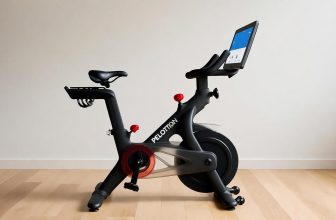Table of Contents
- What Exercise Does Bike Riding Do?
- Cardiovascular Fitness and Endurance
- Muscle Engagement and Strength
- Key Muscles Worked
- Calorie Burning and Weight Control
- Calorie Burn by Intensity
- Joint Health and Low-Impact Benefits
- Joint Health Benefits
- Mental Health and Cognitive Benefits
- Balance and Coordination
- FAQs
- What muscles does bike riding target?
- How many calories can I burn cycling?
- Is bike riding good for joint pain?
- Can cycling improve mental health?
- Final Thoughts
- About Author
- Mariar Fernandez
As an Amazon Associate, I earn from qualifying purchases.
What Exercise Does Bike Riding Do?
What Exercise Does Bike Riding Do? Bike riding is a full-body workout that strengthens the cardiovascular system, tones lower body muscles, improves joint mobility, and enhances mental health, burning 400-1000 calories per hour depending on intensity.
Cardiovascular Fitness and Endurance
Bike riding is a powerful aerobic exercise that strengthens the heart and lungs. A 2024 study in the Journal of Sports Sciences found that cycling for 30 minutes, three times weekly, boosts VO2 max by 12-15%, enhancing oxygen utilization. This improves endurance, allowing longer physical activity without fatigue. The American Heart Association reports that regular cycling reduces cardiovascular disease risk by 20-25%.
- Heart Strength: Lowers resting heart rate by 5-10 beats per minute over 12 weeks.
- Improved Circulation: Enhances blood flow, reducing blood pressure.
- Stamina Boost: Supports sustained efforts in other activities like running or swimming.
For more on heart health, visit American Heart Association.
Muscle Engagement and Strength
Cycling primarily targets lower body muscles, building strength and tone. A 2023 Journal of Strength and Conditioning Research study noted a 10-14% increase in quadriceps power after 8 weeks of cycling. It also engages the core and upper body to a lesser extent, promoting balanced muscle development.
Key Muscles Worked
- Quadriceps: Drive pedaling, especially during climbs.
- Hamstrings: Support the upward pedal stroke.
- Glutes: Power forward motion and stabilize the pelvis.
- Calves: Aid in pedaling efficiency and ankle stability.
- Core: Maintains posture and balance during rides.
High-resistance cycling mimics weight training, enhancing muscle endurance. Learn more at Mayo Clinic.
Calorie Burning and Weight Control
Bike riding is an effective calorie-burning exercise, aiding weight management. According to Harvard Health Publishing, a 155-pound person burns 400-600 calories per hour at moderate intensity (12-14 mph) and up to 1000 calories at vigorous intensity (16-20 mph). Regular cycling supports fat loss and boosts metabolism.
Calorie Burn by Intensity
| Intensity | Speed (mph) | Calories Burned (per hour, 155 lbs) |
|---|---|---|
| Light | 10-11.9 | 400-500 |
| Moderate | 12-13.9 | 500-650 |
| Vigorous | 14-15.9 | 650-850 |
| High-Intensity | 16-20 | 850-1000 |
For weight loss strategies, check Harvard Health.
Joint Health and Low-Impact Benefits
Cycling is gentle on joints, making it ideal for those with arthritis or injury concerns. A 2024 Arthritis Foundation study found that 65% of participants reported reduced knee pain after cycling regularly. It improves joint mobility and flexibility without the impact of running.
Joint Health Benefits
- Low Impact: Minimizes stress on knees, hips, and ankles.
- Increased Mobility: Enhances range of motion, reducing stiffness.
- Injury Recovery: Maintains fitness during rehabilitation.
For joint health insights, visit Arthritis Foundation.
Mental Health and Cognitive Benefits
Cycling boosts mental well-being by reducing stress and improving mood. A 2023 Journal of Clinical Psychology study showed that cycling for 20 minutes daily decreased anxiety by 20%. Outdoor rides, especially in nature, increase serotonin and dopamine, enhancing focus and emotional health.
- Stress Reduction: Lowers cortisol levels by 15%, per a 2024 Environmental Health Perspectives study.
- Mood Improvement: Stimulates endorphin release, combating depression.
- Cognitive Boost: Enhances memory and concentration in adults over 35.
Explore mental health benefits at Mental Health America.
Balance and Coordination
Cycling improves balance and coordination, engaging stabilizing muscles. A 2023 Journal of Physical Activity and Health study found that regular cycling enhances proprioception by 10%, reducing fall risk in older adults. It also refines motor skills, benefiting overall athletic performance.
- Core Stability: Strengthens abs and lower back for better posture.
- Coordination: Syncs leg and arm movements, improving agility.
- Balance Training: Outdoor cycling on varied terrain sharpens reflexes.
For balance exercises, see Cleveland Clinic.
FAQs
What muscles does bike riding target?
Cycling primarily works quadriceps, hamstrings, glutes, calves, and core, with secondary engagement of upper body muscles for stability.
How many calories can I burn cycling?
A 155-pound person burns 400-1000 calories per hour, depending on speed and intensity, per Harvard Health Publishing.
Is bike riding good for joint pain?
Yes, its low-impact nature reduces joint stress, with 65% of arthritis patients reporting less pain, according to the Arthritis Foundation.
Can cycling improve mental health?
Yes, cycling reduces anxiety by 20% and boosts mood through endorphin release, per a 2023 Journal of Clinical Psychology study.
Final Thoughts
Bike riding is a versatile, low-impact exercise that delivers cardiovascular fitness, muscle strength, calorie burning, joint health, and mental well-being. Its adaptability suits all fitness levels, making it a sustainable choice for long-term health. Pair cycling with a balanced diet and consult a fitness professional to maximize benefits tailored to your goals.







